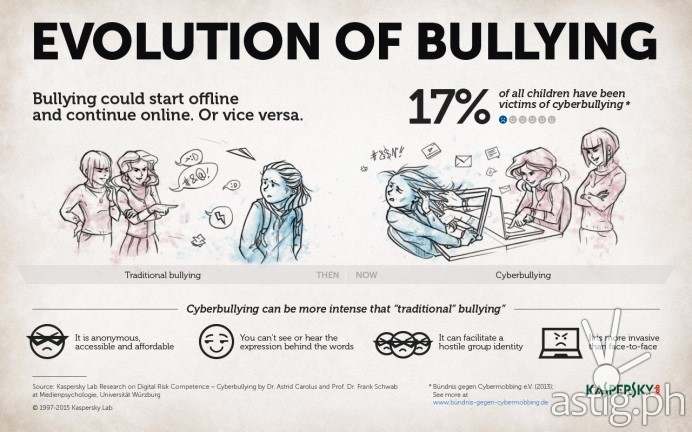MANILA, Philippines – The phenomenon of bullying is nothing new- many adults can recall being bullied in their childhood. Today, the technology has evolved ‘traditional’ bullying from verbal and physical abuse in schoolyard to intimidation in the digital playground, called cyberbullying.
As school is just around the corner, Kaspersky Lab urges parents to be more aware of online bullying as their research titled ‘Digital Risk Competence – Storytelling’ revealed that about 17% of all pupils have been victims of cyberbullying attacks.
The research undertaken by Kaspersky Lab in cooperation with media psychologists from the University of Wuerzburg in Germany showed that one out of five teenagers between the ages of 12-15 have been subject to cyberbullying. This is a critical developmental stage in a young person’s life as children approach puberty and begin to spend more time online.
Also, with the rise in popularity of social media networks such as Facebook, Instagram and Twitter, children’s life offline is becoming more interwoven with his life online.
The Internet opened new doors for bullies to intimidate and hurt the vulnerable teenagers. Likewise, the increased social media use among children has unwittingly open the doors wider and make them more prone to cyberbullying attacks, – Jimmy Fong, Kaspersky Lab’s Channel Sales Director for Southeast Asia.
The rise in social media presence of children in the Philippines exposes more teenagers to cyberbullying incidents.
In a 2011 report from AGB Nielsen, it showed that among the six million Filipino Internet users, almost two thirds or 65% were teenagers. Also, Wave7 2013 report said social media users in the country use networking sites 53 hours a week, while the global average of 42 hours.
But why would this be a concern for the Filipino parents if online bullies cannot physically hurt their kids?
Although cyberbullying does not involve physical violence, there is evidence suggesting online bullying is even more intense than traditional bullying for the following reasons:
- It is anonymous. As cyberbullying can remain faceless in an anonymous online setting it is harder to establish the bullies’ identities and to prove who is ultimately responsible. This also means that the bullies are less connected to the damage they cause and can take things further as a result.
- It is hard to escape. Most people today have access to the Internet and all humiliating information that is stored online can theoretically be accessible forever, by everyone.
- Online all of the time. It is more difficult to escape from cyberbullying because victims are contactable via computers or smartphones, anytime and anywhere.
- It is more invasive than face-to-face interaction. The bullies and the victims cannot see each other. Consequently, they are unable to see their counterparts’ facial expressions, gestures or spatial behavior. Bullies become even more detached from the damage they are causing and as a consequence they become less concerned about the feelings and opinions of others.
These show that cyberbullying is a real issue. It happens every day online and if you are to help stop cyberbullying then you need to recognize the signs. To help the parents identify if their kid is a victim, Kaspersky Lab lists down four simple signs:
1. Change in mood
A sudden change in mood over a period of time may be an indication that a person is being cyberbullied. It can also be a sign of other issues, but if you recognize the signs above you should firstly try and rule out cyberbullying by having a gentle conversation that is non-judgmental and friendly
2. Feeling fearful
Fear is an emotion that should raise cause for concern and if a person is feeling fearful frequently it may be a sign of cyberbullying. It can also be a sign of other issues, but if you spot fear in a person you care about then you should firstly try and rule out cyberbullying.
3. Closed down social networking profiles
A person being cyberbullied may shut down some or all of their social networking sites to avoid abuse or messages from the cyberbully. If you know somebody who has suddenly disappeared from social media for an unexplained reason, they might be trying to protect themselves from cyberbullying. If you are concerned about a loved one or a friend, then talk to them.
4. Public images or messages that are derogatory or abusive
Bullying can happen very publicly so you may be witness to it on social networking sites, Internet forums or on gaming devices. Messages may be directed at a person you know or are friends with online for everyone to see.
Aside from protecting your kids online, it is also important to teach them about the responsible use of technology, especially the social media networking sites.
“Children need to develop a sense of morality when they are interacting with other people online, just as much as they do when they are communicating offline. This will give them more empathy and reduce the likelihood of them opting to engage in cybercrime or cyberbullying,” said David Emm, Security Researcher at Kaspersky Lab.
“It’s also important so that they understand, from an early age, the potential dangers associated with some online activities,” Emm added.

